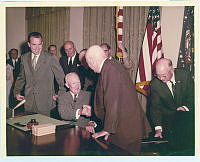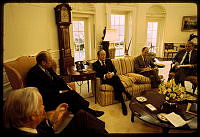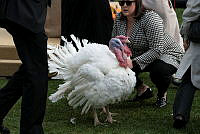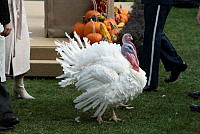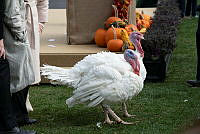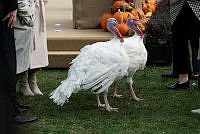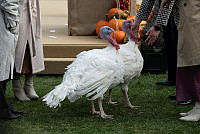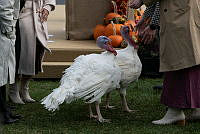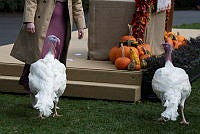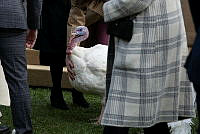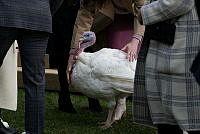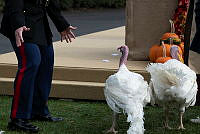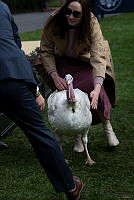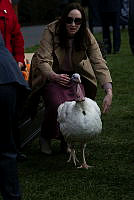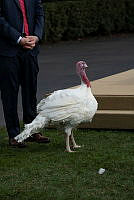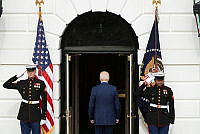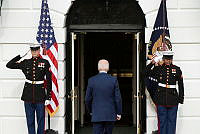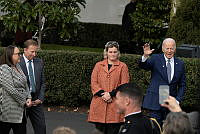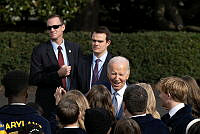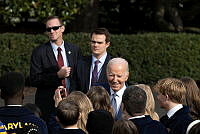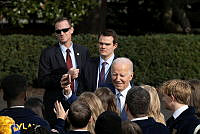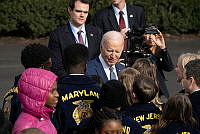Rubenstein Center Scholarship
The Vice-Presidency
Evolution of Home and Office
In 1848, Senator Daniel Webster of Massachusetts was offered the vice-presidential nomination for the Whig Party, alongside presidential nominee Zachary Taylor. Webster, known for his oratory and quick wit, allegedly responded, “I do not propose to be buried until I am really dead and in my coffin.”1
Notwithstanding Webster’s observation, the vice presidency as an office has gradually grown in power and stature over the past century. The evolution of the vice presidency has been incremental, with increasingly prominent individuals accepting the role (such as Theodore Roosevelt, Calvin Coolidge, Harry Truman) and more substantive tasks assigned to those who occupied it.2 The growth in stature of the office, along with security concerns and an accretion of duties, necessitated the congressional designation of Number One Observatory Circle as the official home of the vice president.
The early vice presidency had limited powers and efficacy. According to the April 24, 1789 first-hand account in the daily journal of Senator William Maclay, John Adams summed up his vice-presidential role as such: “I am nothing but I may be everything.”3 The primary constitutional duty of the vice president is to preside over the Senate as its president. Article I, Section 3 of the United States Constitution states that the vice president has no vote in the Senate unless there is a tie. In his or her capacity as president of the Senate, the Vice President of the United States opens all presidential election certificates and presides over the counting of the Electoral College votes.4
The Twelfth Amendment, ratified in 1804, was the first major change to the office. It separated the election of the president and vice president, requiring each elector to cast a separate vote for each office. This prevented a minority party from attempting to extract concessions from the opposing party’s vice-presidential candidate in exchange for electoral votes. It also clarified that the constitutionally mandated criteria for the presidency likewise applied to the vice presidency.5 The second major change in the office occurred in 1841 when President William Henry Harrison died in office. Per Article II, Section 1 of the Constitution, Vice President John Tyler assumed the presidency. There was debate concerning whether Tyler became President of the United States or only gained the powers of the role in an acting capacity. Tyler settled the question by asserting he had indeed become the president and was not merely acting as such, taking the Oath of Office after arriving to the nation’s capital two days after Harrison’s death.6 Tyler thus established the precedent of succession in the office, solidifying Adams’ earlier assertion that the vice president indeed “may be everything” when circumstances demanded it. In the nineteenth century, three more vice presidents succeeded to the presidency (Millard Fillmore, Andrew Johnson, and Chester A. Arthur).

This engraving depicts Vice President John Tyler at Sherwood Forest, his estate in Virginia, receiving news from a messenger regarding the death of President William Henry Harrison.
Library of CongressEarlier in American history, it was unclear if the vice presidency resided predominantly in the executive or legislative branch of government. In the twentieth century, the vice presidency began to migrate toward the executive, which gave it more of an independent identity and purpose. For example, Warren Harding asked his vice president, Calvin Coolidge, to attend cabinet meetings regularly; earlier vice presidents had only attended sporadically or when substituting for an absent president.7 Vice President John Nance Garner assisted with New Deal legislation during Franklin Roosevelt’s presidency. After World War II and Vice President Harry Truman’s lack of awareness about the development of the atomic bomb, Congress included the vice president as a member of the newly created National Security Council.8 Three presidents died in office during the first half of the twentieth century (William McKinley, Warren Harding, and Franklin Roosevelt), further heightening the importance of the vice-presidential role.
The enhanced role of the United States on the international stage and the growth of the national government increased expectations for presidential visibility and travel. Presidents began to look to their running mates as partners who could shoulder additional requirements of the office. Vice President Richard Nixon visited fifty-four countries and also accepted a number of specific executive branch assignments from President Dwight Eisenhower.9 After the assassination of President John Kennedy, the Twenty-Fifth Amendment was added to the Constitution, which specifically addressed presidential and vice-presidential succession. The inclusion of the vice presidency in this amendment indicated the office was now significant enough for succession planning.
A major development in the vice presidency occurred during the administration of Jimmy Carter. After Senator Walter Mondale joined the ticket, Mondale prepared a memorandum about how he envisioned his role as vice president. President Carter concurred with Mondale’s analysis and provided him with an office in the West Wing. Carter viewed Mondale as a partner and adviser, elevating the vice presidency and drastically affecting its future trajectory.10 Mondale’s vice presidency is considered by scholars as the “big bang” that transformed the office permanently.11 Along with added responsibilities came increased support and resources for the vice president, such as additional staff. Notably, Vice President Walter Mondale became the first vice president to occupy an official residence, located at Number One Observatory Circle.

On December 18, 1977, Vice President Walter F. Mondale and Second Lady Joan Mondale host a dinner for President Jimmy Carter, First Lady Rosalynn Carter, and their family at the vice president's residence.
Jimmy Carter Presidential Library and Museum/NARAIn 1974, Congress had designated Number One Observatory Circle as the temporary residence of the Vice President of the United States. Congress also provided for the staffing, equipment, furnishings, dining facilities, and other services required for the vice president to fulfill the functions of the office. Such provisions would be provided by the Secretary of the Navy, subject to the supervision of the Vice President of the United States.12
Previously, vice presidents lived in private residences, ranging from apartments to suburban houses to hotel rooms.13 As the office grew in importance throughout the twentieth century, providing security for the various residences of vice presidents became increasingly problematic. Between 1965 and 1977, five different individuals served as vice president (Hubert Humphrey, Spiro Agnew, Gerald Ford, Nelson Rockefeller, and Walter Mondale). Each specific living arrangement posed challenges for the Secret Service.14 Besides providing the vice president with a greater degree of independence for hosting guests and diplomatic events, an official residence also simplified the burden of securing his or her safety.

On September 7, 1975, Vice President Nelson Rockefeller and Second Lady Happy Rockefeller welcome President Gerald Ford, First Lady Betty Ford, and daughter Susan Ford to tour the vice president's residence at One Naval Observatory.
Gerald R. Ford Presidential Library and Museum/NARACongressional consideration of the vice president’s official residence began with hearings in 1966. Several potential locations were discussed in those hearings, including the Sewall-Belmont House (now the Belmont-Paul Women’s Equality National Monument) on Capitol Hill. The subcommittee chairman in charge of public buildings and grounds, Representative Kenneth Gray, determined that the Naval Observatory provided the best option for a vice-presidential residence. However, due to the ongoing war in Vietnam and budgetary considerations, Congress decided not to build a new home at that time, and the issue lingered.15 When hearings resumed in 1974, Congress considered the option of finding a suitable residence for the vice president rather than initiating new construction. Members of Congress began to consider that the existing mansion at One Observatory Circle within the Naval Observatory grounds could serve as a suitable official residence for the vice president. At that time, the United States Navy, whose Chief of Naval Operations (CNO) Admiral Elmo R. Zumwalt occupied One Observatory Circle, objected. However, the testimony of the Secret Service was determinative, arguing that One Observatory Circle was an ideal location for an official residence from a security perspective.16
The United States Naval Observatory is located on seventy-two acres in northwestern Washington, D.C. The Naval Observatory is a working installation of the United States Navy, serving as the Department of Defense’s “authoritative source for the position and motion of celestial bodies, motions of the earth, and precise time.”17 Before the Navy’s occupation, the site was owned by Margaret Barber, a wealthy landowner who enslaved dozens of people prior to District of Columbia emancipation. In 1862, as a result of the District’s Compensated Emancipation Act, Barber received compensation for the people she enslaved, claiming thirty-four individuals. This made her one of the largest owners of enslaved people in the nation’s capital. Most of those individuals did not work on her land. She hired out many of the enslaved people for their labor; only five people worked within her household, likely performing domestic tasks.18 Margaret Barber sold her estate to the United States Government in 1881. Recent excavations on the land have uncovered artifacts from the nineteenth century, including the underlying structure of a plantation smokehouse.19
In 1886 and 1891, Congress approved funding to construct new buildings and move the United States Naval Observatory from Foggy Bottom to its current site, which is geographically situated on a hill north of Georgetown.20 The Superintendent’s home was built at this time, designed by prominent Washington, D.C. architect Leon Dessez. In 1929, the home became the residence of the Chief of Naval Operations (CNO). The CNO resided at One Observatory Circle until 1974, when Congress designated it officially as the temporary residence of the Vice President of the United States.21

This winter photograph of the vice president's residence at the United States Naval Observatory was taken on January 17, 1977.
Library of CongressOf the seventy-two acres at the United States Naval Observatory, the Vice President’s residence occupies twelve. The main gate to the complex is also called the North Gate, located at 34th Street NW. This entrance is restricted since this gate serves as the entryway to the vice-presidential residence and the surrounding Secret Service areas. The three-story house is a Queen Anne style, which includes classic columns, bay windows, a gable, and a wrap-around porch. The public can catch a glimpse of the back of the house from the Main Gate, particularly during the winter months when foliage is sparse. There are no public tours of the residence or grounds.22
In 1991, Vice President Dan Quayle oversaw the creation of the Vice President’s Residence Foundation, a private, nonprofit organization that enables the current vice president and second spouse to make cosmetic, aesthetic, or discretionary improvements to One Observatory Circle without relying on federally appropriated dollars. Required structural repairs are provided by the United States Navy using government funding.23 The United States Navy also provides stewards, cooks, a cleaning team, and gardeners.
One Observatory Circle is a residence for the vice president and his or her family. Additionally, it serves as a place for official meetings and events. Even though Vice President Nelson Rockefeller chose to live at his privately-owned estate in Washington, D.C. instead of moving into the vice-presidential residence, he and his wife Happy Rockefeller hosted several social events at One Observatory Circle. Several of the gatherings included prominent public figures, such as Barbara Walters, Cary Grant, and Alan Shepard.24 Since then, vice presidents have used One Observatory Circle for entertaining guests and other formal events. In 1997, Vice President Al Gore and his wife Tipper Gore hosted a 300-person wedding reception on the grounds of One Observatory Circle for their daughter Karenna.25

In 1981, President Ronald Reagan plays with C. Fred, the dog of Vice President George H.W. Bush and Second Lady Barbara Bush, as Nancy Reagan signs the guest book at One Naval Observatory.
George Bush Presidential Library and Museum/NARASecond spouses have played a major role in hosting events that bring attention to various worthy causes. For example, Joan Mondale exhibited American art at the residence while Barbara Bush promoted literacy. More recently, Jill Biden hosted barbecues for service members injured from Walter Reed Army Medical Center.26
One Observatory Circle had undergone several renovations over the past forty years. Some changes have been necessary to protect vice presidents and their families. Bullet-proof windows and a steel picket fence have been added, as well as updated electrical, heating, and security systems. Other changes have increased the beauty and utility of the property. The Mondales planted a tulip garden on the grounds in 1980, while George H.W. Bush built a horseshoe pit.27 In 1991, the Quayles added a heated in-ground swimming pool, a popular feature of the residence.28 After moving into the vice-presidential residence in 1993, Tipper Gore realized there was no inventory cataloguing available furnishings and other items. In response, she implemented a computerized inventory system that identified all furniture and decorations available to One Observatory Circle residing families. The Gores also installed a family kitchen on the second floor of the house so that normal family routines could be maintained.29

First Lady Michelle Obama and Second Lady Jill Biden host a Joining Forces initiative tea for the senior spouses of military leaders on June 25, 2014 at One Naval Observatory.
Official White House Photo by Chuck KennedyVice President Richard Cheney likely oversaw the construction of an extensive underground bunker at One Observatory Circle, built after the terrorist attacks of September 11, 2001. The existence of such bunker has not been confirmed by the White House, the Secret Service, or a national security agency. However, Vice President Joe Biden spoke publicly about the bunker at the 2009 Gridiron Club dinner. Later, Vice President Biden’s press office clarified the remark, stating that he was speaking about a hidden door leading to an upstairs office.30 Nonetheless, Vice President Cheney subsequently confirmed in his published memoir that the vice president’s residence included an “undisclosed location” that ensured his safety during times of elevated national security concerns.31
In 2012, the Bidens added a Family Heritage Garden to the grounds, near the front lawn. Jill Biden conceived of the idea after admiring the Children’s Garden at the White House on the South Lawn. The Family Heritage Garden features a water fountain in the center of the design; the names of each vice president’s family members (including pets) who lived at One Observatory Circle are inscribed on flagstones encircling the fountain.32 In 2017, along with Agriculture Secretary Sonny Perdue, Karen Pence installed a beehive on the grounds of the vice-presidential mansion to draw attention to reduced honeybee populations in North America.33

Vice President Mike Pence and Second Lady Karen Pence host a Halloween party at the vice president's residence on October 30, 2019.
Official White House Photo by Tia DufourAddressed to her administrative assistant, the most often-repeated line of Selina Meyer’s vice-presidential character on the television show Veep was “Sue, did the president call?” Despite the intended humor, vice presidents no longer wait around for their boss to call. A role that started out as a constitutional necessity for succession has developed into a powerful institutional actor in American government. As the complexity surrounding presidential leadership and governance continues to grow at an accelerated rate, vice presidents will play an increasingly critical role in national governance, executive branch administration, and decision-making.













